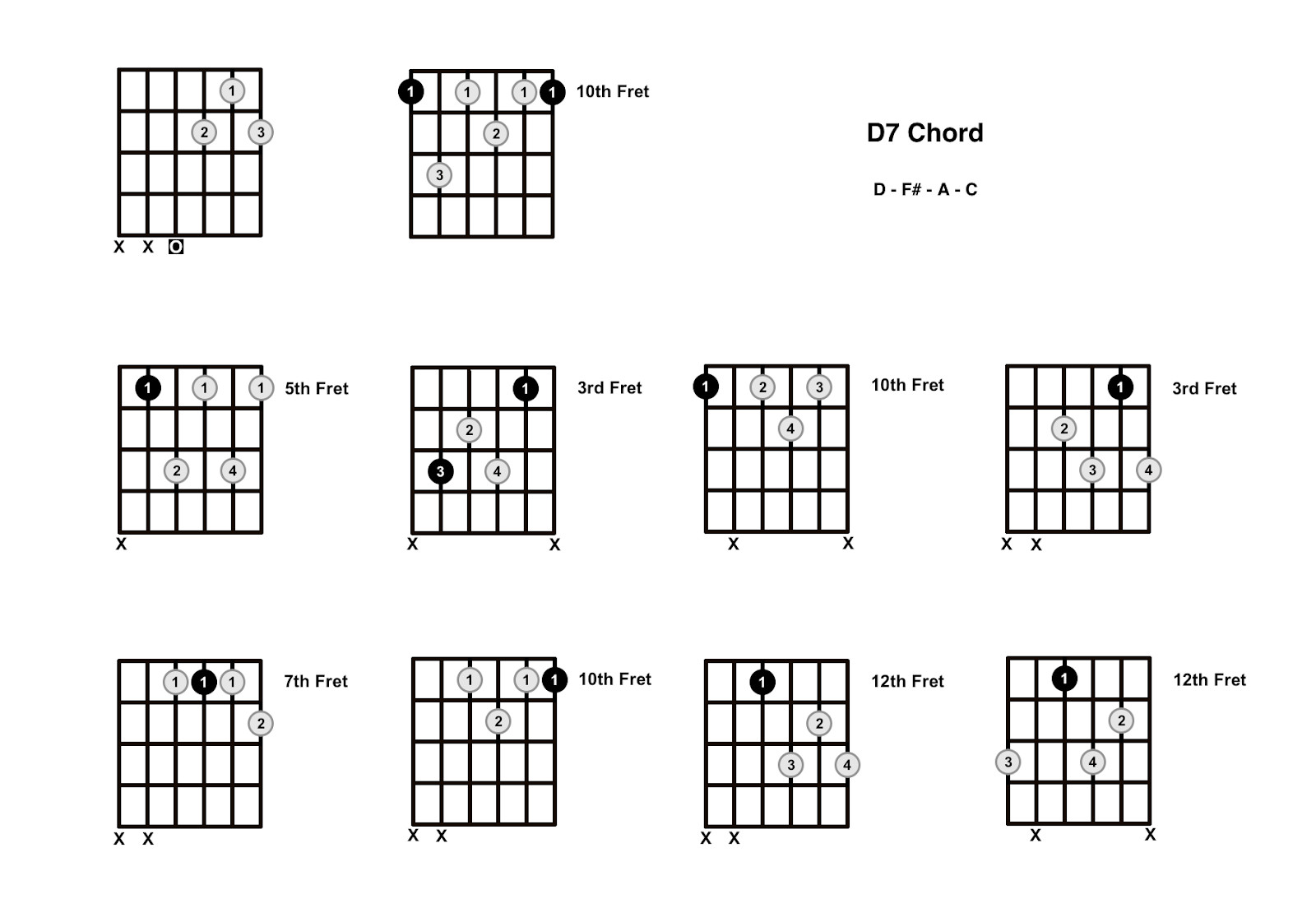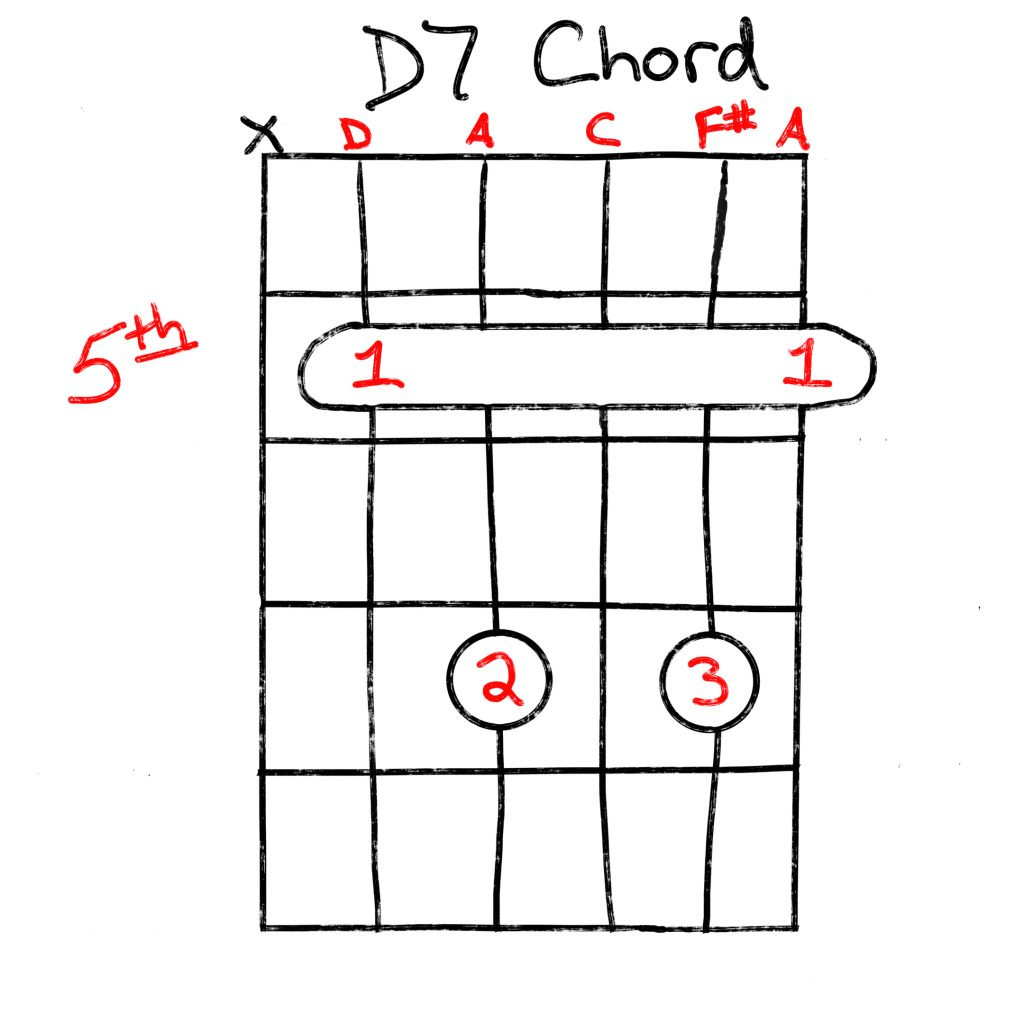The D7 Guitar chord is a staple for guitarists across genres, adding a distinctive flavor to everything from blues and jazz to country and rock. If you’re looking to enrich your chord vocabulary and bring a more vibrant sound to your playing, understanding and mastering the D7 chord is essential. Whether you’re just starting your guitar journey or seeking to refine your chord skills, this guide will provide you with everything you need to know about the D7 guitar chord.
Often referred to as the D dominant seventh chord, the D7 is closely related to the B7 guitar chord in terms of its function and sonic character. This chord is known for creating an “uplifting” or slightly bluesy sound, making it incredibly versatile and popular in various musical styles. Its presence is strongly felt in country, mellow rock, jazz, classical music, and even some pop tunes. Learning the D7 chord opens up a world of musical possibilities, regardless of your preferred genre.
The versatility of the D7 chord stems from its ability to build anticipation and tension in chord progressions. It frequently acts as a dominant chord, naturally leading to resolution and harmonic satisfaction. For any aspiring guitarist, familiarity with the D7 chord is not just beneficial, it’s fundamental.
Let’s explore the different ways you can play this essential chord on your guitar.
Unlocking the D7 Chord: Finger Positions and Techniques
The D7 chord is built from four notes: D, F#, A, and C. These notes consist of the root (D), the major third (F#), the perfect fifth (A), and the flat seventh (C) of the D major scale.
To form the D7 chord on your guitar, you’ll need to position your fingers precisely on the fretboard. The most common and beginner-friendly method is the open D7 chord.
The Open D7 Chord: Your Starting Point
This is often the first D7 chord that guitarists learn due to its relative ease of fingering.
Finger Placement:
- Index Finger (1st Finger): Place this finger on the 2nd fret of the G string (3rd string from the thickest).
- Middle Finger (2nd Finger): Position your middle finger on the 2nd fret of the high E string (1st string, thinnest string).
- Ring Finger (3rd Finger): Place your ring finger on the 3rd fret of the B string (2nd string).
 D7 Chord Open Position Diagram
D7 Chord Open Position Diagram
Image showcasing the open D7 chord finger position on a guitar fretboard.
Once your fingers are in place, strum the strings from the D string (4th string) downwards. It’s crucial to avoid strumming the Low E string (6th string) in this voicing of the D7 chord to achieve the correct sound. Accidentally including the Low E string is a common mistake for beginners.
Variations of the D7 Chord: Expanding Your Options
As you become more comfortable with the open D7 chord, you can explore other voicings and variations. Here are a couple of common alternatives:
D7 Chord with Open A String
This variation is essentially the same as the open D7, emphasizing the lower frequencies slightly by allowing the A string to ring openly.
- Finger Placement: Same as the Open D7 Chord.
- First Finger: 2nd fret of the G string.
- Second Finger: 2nd fret of the high E string.
- Third Finger: 3rd fret of the B string.
D7 Chord with Open G String
This is another slight variation, again mirroring the open D7 fingering. The open G string provides a slightly different tonal color.
- Finger Placement: Identical to the Open D7 Chord and D7 Chord with Open A String.
- First Finger: 2nd fret of the G string.
- Second Finger: 2nd fret of the high E string.
- Third Finger: 3rd fret of the B string.
The Barre D7 Chord: Mobility and Higher Positions
For greater flexibility and the ability to play the D7 chord in different positions on the neck, the barre D7 chord is invaluable. This movable form allows you to play the D7 chord (and other dominant 7th chords) up and down the fretboard.
Finger Placement:
- Index Finger (1st Finger): Barre across all six strings at the 2nd fret. This means pressing down all strings with your index finger right behind the 2nd fret.
- Middle Finger (2nd Finger): Place this finger on the 3rd fret of the B string.
- Ring Finger (3rd Finger): Position your ring finger on the 4th fret of the D string.
- Pinky Finger (4th Finger): Place your pinky finger on the 5th fret of the A string.
 D7 Barre Chord Diagram
D7 Barre Chord Diagram
Image illustrating the barre D7 chord shape on the guitar neck.
This barre chord shape can be moved up the neck to play other 7th chords. For example, moving this shape up two frets would create an E7 chord.
D7 Chord in Action: Popular Songs to Practice With
Learning chords is always more engaging when you can apply them to real songs. The D7 chord is featured in countless popular songs across various genres. Here are a few well-known examples perfect for practicing your D7:
-
“Can’t Help Falling In Love” – Elvis Presley: This timeless classic, released in 1961, prominently features the D7 chord progression in its chorus. Its gentle melody and simple guitar accompaniment make it an excellent choice for practicing smooth chord changes involving D7. You can find numerous guitar tutorials for “Can’t Help Falling In Love” on YouTube to learn the specific chord progression.
-
“Ain’t No Sunshine” – Bill Withers: Released in 1971, this soulful hit is instantly recognizable for its repetitive and emotionally charged chord progression. The D7 chord is a recurring element in “Ain’t No Sunshine,” providing ample opportunity to practice transitioning to and from the D7.
-
“Brown Eyed Girl” – Van Morrison: A feel-good classic from 1967, “Brown Eyed Girl” reached the top 10 on the US Billboard Hot 100 chart and remains a beloved song. The D7 chord plays a crucial role throughout the song. Learning to play “Brown Eyed Girl” is a fun way to solidify your D7 chord skills within a musical context.
Integrating the D7 Chord into Chord Progressions and Musical Contexts
Understanding how to use the D7 chord effectively within chord progressions will significantly enhance your guitar playing.
D7 as a Dominant Chord
The most common function of the D7 chord is as a dominant chord in the key of G major (or D major, leading to G). In this context, the D7 creates tension that naturally resolves to a G major chord. This dominant-tonic relationship is fundamental in Western music and is frequently used across genres.
For example, a simple and common progression using D7 is: D7 – G. This progression creates a strong sense of resolution and is widely used in blues, jazz, and country music.
Substituting D Major with D7
A frequent question from guitarists is whether you can substitute a D7 chord for a D major chord. The answer is generally yes, in many situations! While the D major chord is bright and stable, the D7 adds a layer of complexity and tension. Substituting D with D7 can inject more dynamic interest into your chord progressions and arrangements. Experiment with replacing D chords with D7 chords in songs you already know to hear the difference.
Chords that Pair Well with D7
The D7 chord naturally harmonizes with several other chords. Depending on the key and musical style, common chord pairings include:
- G Major: As mentioned, the tonic chord in the key of G, creating a strong dominant-tonic resolution.
- E Minor: Can create a bluesy or jazzy feel when used in progressions with D7.
- A Major (or A7): Can function as a subdominant chord or create further harmonic movement when paired with D7.
Elevate Your Guitar Skills with guitarplayers.net
At guitarplayers.net, we are dedicated to providing comprehensive and accessible guitar lessons for players of all levels. Whether you are a complete beginner or an experienced guitarist, our resources are designed to help you expand your skills and deepen your musical understanding.
Our lessons, crafted by experienced guitar instructors, cover a wide range of topics, from fundamental chords like the D7 to advanced techniques and music theory concepts. We believe in a practical, hands-on approach to learning, ensuring that you can immediately apply what you learn to your playing.
Explore our extensive library of guitar lessons and resources to continue your musical journey and unlock your full potential as a guitarist.
Frequently Asked Questions about the D7 Chord
How do I use the D7 chord in a chord progression?
The D7 chord is most commonly used as a dominant chord, creating tension and resolving to the tonic chord, often a G major chord in the key of G major. Experiment with progressions like D7-G, or incorporate it into blues progressions.
Can I substitute the D7 chord for a D chord?
Yes, absolutely. In many cases, you can substitute a D7 chord for a D major chord to add a richer, more complex, and slightly bluesier sound to your playing. It injects more tension and harmonic interest.
What other chords can I use in combination with the D7 chord?
D7 pairs well with chords like G major, E minor, and A major (or A7). The specific chords that work best will depend on the key and the style of music you are playing, but these are excellent starting points for experimentation.
